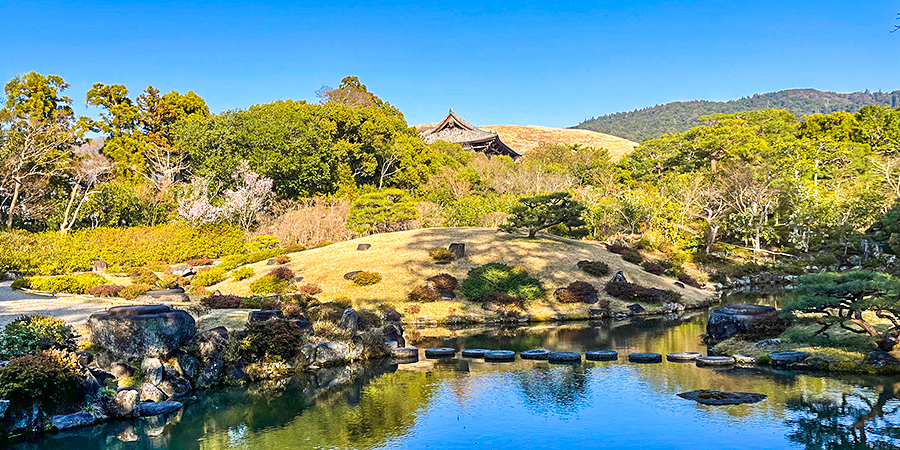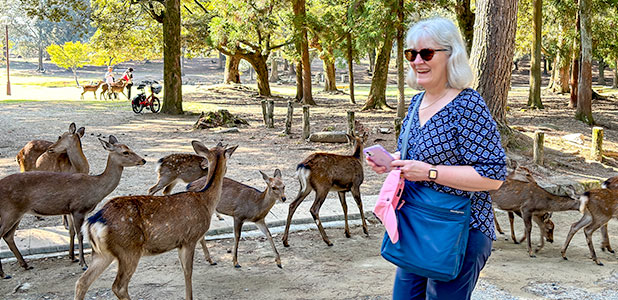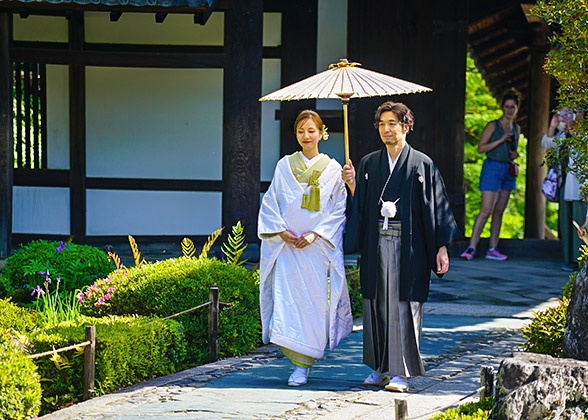Isuien Garden
Isuien Garden located in the west of Nara Park, is a traditional Japanese garden. It is mainly made up of the front garden and the back garden. There are also tea houses where visitors can take a seat to enjoy the natural landscape comfortably. One should also not miss appreciating the ancient bronzes and porcelains in the Neiraku Museum of Art by the entrance of the garden.Front Garden and Back Garden of Isuien Garden
The front garden was designed in the Edo Period (1603-1868), and mainly contains a pond, a tea room, and a museum. The back garden is bigger than the front garden, and it was established in the Meiji Period (1868-1912). Standing in the back garden, south gate of Todaiji Temple and Mountain Wakakusa can be seen, and the landscaping technique is called “shakkei” which means borrowing the scene from other places.

Isuien Garden Photos ( 17
|
Best Time to Visit Isuien Garden
The natural landscape of the garden in April and October is stunning. In spring, you can see varied flowers, like Japanese apricot, weeping cherry, three-leaf azalea, wisteria, and iris. In autumn, the large red and orange maple leaves and turquoise lake set off each other. The garden is quite quiet and a nice place to get away from the crowds.
|
|
|
Neiraku Museum of Art
The museum owns more than 2,000 varied collections, like ancient Chinese bronzes, porcelains, stone tablets, and Japanese tea ceremony utensils. Due to the limited space of the museum, the collections cannot be shown at one time, but the staff change the displays regularly. Besides, during spring and fall, you can see the paintings of Japanese famous artist TANOMURA Chikuden (1777-1835), including the paintings “Matamata Ichiraku jo” which is listed as an important cultural property of Japan. The admission fee is included in the ticket of Isuien Garden.Tea Houses
There are totally four tea rooms inside the garden, namely Sanshutei Tea House, Hyoshintei Tea House, Seishuan Tea House, and Teishuken Tea House. Sanshutei Tea House is located in the front garden, and it provides varied meals and drinks. You can taste the Japanese specialty drinks, like Matcha and Sencha. Besides, you can appreciate the garden view through the window of the tea room.Matcha refers to powdered steamed green tea that taste a little bitter. Sencha refers to steamed green tea that taste sweet. The price of a cup of tea with dessert is around 1,000 yen.
|
|
|
Opening Hours:
The tea houses provide meals from 11:30 to 14:00 and drinks from 10:30 to 13:30.Tips:
1. The garden provides free English guiding service, and you can ask the staff for details.2. If you visit the garden during the summer, please bring a sunshade as there is no much shade or place to rest in this garden except the tea houses.
3. You are not allowed to eat food in the garden except in the tea houses.
4. No smoking in the garden please.
Opening Time and Ticket Fare of Isuien Garden
Isuien Garden is open from 9:30 to 16:30, but you need to enter before 16:00. It is generally closed on Tuesdays, from the end of December to the middle of January, and during the last third of September for maintenance. The admission fee is 1,200 yen.How to Get to Isuien Garden
1. You can take the Kintetsu Nara Line, and get off at the Kintetsu Nara Station. Then, walk for about 13 minutes to get there.2. You can take the JR Nara Line, and get off at JR Nara Station. Next, take the Nara bus at the JR Nara Bus Stop (East Gate), get off at Kenchoazuma Bus Stop and walk to Isuien Garden. It takes about 15 minutes from the JR Nara Bus Stop to Isuien Garden.
Recommended Time for a Visit
About 1 Hour.Nearby Attractions to Visit
After appreciating this Japanese traditional garden, you can visit the nearby temples and shrine, like Todaiji Temple, Kofukuji Temple, and Himuro Shrine. Besides, you can learn about Buddhist culture in the Nara National Museum and feed deer in the Nara Park.
See More:






